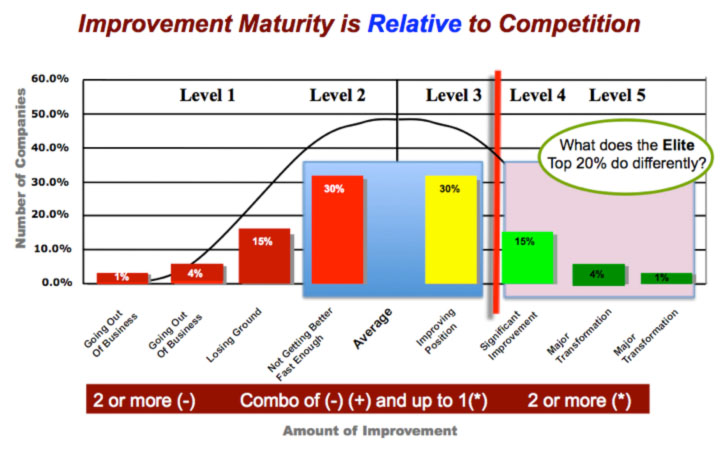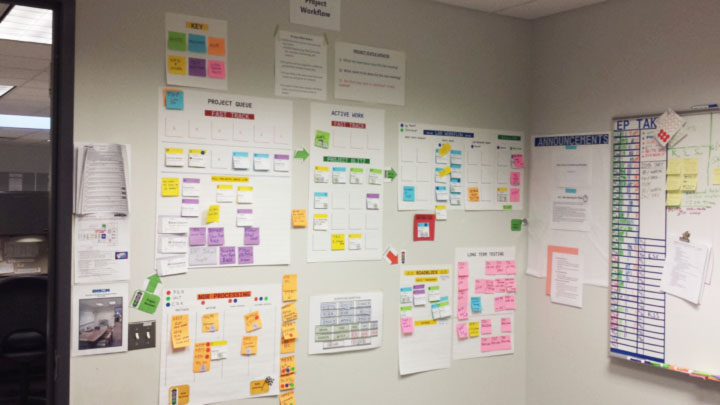We all make choices every day about improvement. Very often our habits are so ingrained we don’t even realize we are making a choice, as we operate on automatic.
Organizations as a whole also suffer this same conundrum. It’s usually quite exciting at the beginning of an improvement journey as change begins to happen, but as time goes by the leadership team tends to revert back to automatic behaviors (old habits). That is the way most companies go about improvement. So whilst most organizations improve somewhat, their competitive position rarely changes in a significant way. The diagram below from “Escape the Improvement Trap” shows most companies are ‘average’ in terms of improvement effectiveness.

You might wonder, “Why do leaders operate this way?” The answer is quite simple, “You typically don’t get in trouble when you do it the same way everyone else does it; it’s the safe thing to do.” But this type of behavior is quite uninspiring.
So the key question for anyone who is a leader is, “Do you desire to become a much more effective leader?” Which begs yet another question, “Why bother?” There is one key reason.
National employee surveys from Gallup, Wyatt, and the rest indicate that less than 30% of employees are highly or very highly engaged in their work. The single largest factor influencing this statistic is the quality of the leader to whom they report – the employees’ direct supervisor. Not the CEO or the leadership team. Obviously, it would be wonderful to work for an enlightened and competent CEO and her equally enlightened leadership team. But that is simply not the case for most of us.
What can you do as an individual leader working in an organization that is average? The answer is plenty! First, you might ask yourself though, do you really desire to become a more effective leader? The knee jerk response is “YES” but changing your leadership style means changing a habit. It’s hard work!
Over my career, I’ve come to observe differences at a handful of organizations highly effective at improving vs. the rest. Leaders in elite organizations use a different mental model than ‘average’ companies. They operate with a high degree of humility (which makes them good listeners/learners) and they have high expectations for excellence and accountability.
Here are three actions – if you practice doing them, so they become a new habit – you can use to become a more effective leader:
1. Change your perspective
- Use simple tools to create pictures (e.g., process maps, simple assessments, etc.). These pictures will yield new insights.
- Understand ‘why?’ If people don’t have a clear understanding of a meaningful ‘why’ it is difficult for them to work passionately. There is always a why, but it rarely invites passion. Consider software development. The first level why is to solve a coding issue that is staring me in the face, but why do we have that issue? What is the intended purpose of the software? Is it more effective use of an analyst time? To do what? How do people go about doing the work or using the object the software is supposed to improve? Keep digging to understand context.
- Become a Process Thinker. People say they are ‘process thinkers’ but most don’t manage this way. Dr. W. Edwards Deming once said, “85% of all performance problems are process problems, not people problems.” So if an individual is not performing well, what process issues might contribute to this? The on-boarding process, the hiring process (did we hire the right skills), easy access to the right information, the way you hold people accountable (using fear is not a good idea), ignoring cross-functional realities, etc. Think about processes with a capital “P” and you will start to look at the world in a different way. There is tremendous benefit from operating this way. Great LEI article about getting ‘individualist’ type people to do standard work (which is a process) Surf Culture Meets Standard Work.
2. Support Others –– Be thoughtful of your messaging. There was a store in the Southeastern part of the U.S. that posted the following window sign: NOW HIRING and a sign right above it saying STORE CLOSING. Conflicting messages cause confusion. Do you communicate it is safer for people to lay low and stay out of trouble or is it a positive message of engagement? You can use a Gemba Walkto focus on people and to challenge your own assumptions.
- ‘Go See’. As what you assume is happening is probably different from the reality of the situation. First seek to listen and learn, find-out what makes work difficult to do.
- ‘Ask good questions and listen’ to the response. What are the targets? Why are they important? Do people understand the ‘why’? Why is performance less than desired? What is inhibiting progress? Questions like these move you toward becoming a process thinker and they help a leader to become an effective coach. Never ask ‘who’ is responsible for a problem, always try to understand ‘why’ the situation exist.
- ‘Have humility and show respect.’ Listen more than you talk. Create a safe environment for people to tell the truth, as they perceive it. This will pay considerable dividends. Never get defensive, always seek to learn and understand. Don’t remove problem ownership, trust people to act when they learn to ‘see it.’
3. Make it Visual –– Make your metrics VISUAL. Provide simple, rapid and meaningful feedback on daily performance. The best visuals change behaviors. If everyone is pretty much working the same old way they always did, then your visuals have NO IMPACT. For a short simple article on the power of visual feedback check this post on LinkedIn by Scott Smith Visual Management to Reduce Electricity consumption
Next, find a way to publicly hold yourself accountable and link the changes being made to meaningful and desirable results for your organization. You might post your Gemba Walk activities on a wall or find some other way to visually demonstrate how your team is working more effectively and collaboratively.
For example, several leaders at Bison Gear and Engineering in St. Charles, IL decided to work in a more collaborative fashion in order to improve their ‘hit’ rate on the Request for Proposal Process. Sales, operations, purchasing, and engineering met once per week to review progress on proposals with the help of simple visuals they created and posted up on the walls.

Photo by Jordan Kapitanoff 2015
Over an 18-month period they decreased their lead-time for proposal response by more than 50% and more than doubled their hit rate for winning desirable proposals. This transformation started with an individual engineer trying to visually display workloads in Engineering. They focused on improving their area first before engaging the other departments. Build credibility first!
We all make choices every day. One of my favorite quotes on leadership was by John Quincy Adams from more than 200 years ago, “If your actions inspire others to dream more, learn more, do more and become more, you are a leader.” Actually a very effective leader!
You can become a better leader. But to do that you must change. That’s your first challenge.



